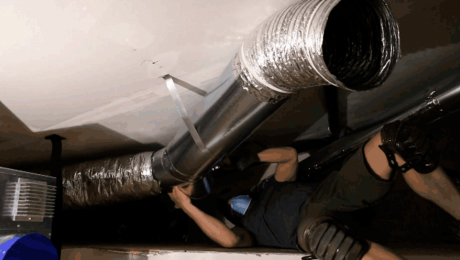Working by Yourself: Tips From a Solo Carpenter
Think working alone will lead to low-quality results? Well, you might be surprised when it ups your game.
In a recent episode of the Fine Homebuilding podcast, we were discussing whether it was possible to do quality, efficient jobs when working solo. My argument is that it is absolutely possible, and that the majority of the work I do, I do alone.
In this short video alone you’ll see several examples of a workflow that’s built around working solo.
- When working overhead, I like to use homemade scaffolding. When you have to focus on balancing a board by yourself, you’ll appreciate having a wide, stable scaffold to work from.
- Many teams of carpenters rely on either measuring in team (one at the smart end of a tape measure and the other at the hook) or lifting a piece into place, marking where it needs to be cut, and then climbing down to make the cut. Instead, I often use a laser distance measure to get accurate dimensions to work from. It’s also helpful to think about how pieces will come together, because you often can get away with cutting a board just shy of full length, giving you some leeway for adjustment.
- I learned the value of temporary brackets from John Carroll (check out his excellent book, Working Alone by The Taunton Press) and have been using them for a variety of tasks ever since. Here I’m attaching them to the underside of the beam, set to the exact height that I need my trim board to overhang the beam. This way the piece of trim can be lifted into place and just set on the brackets. This frees me up to move my ladder, or shift my attention to the corner where my miter needs to come together, and I have both hands available for fastening.
Even if you work as part of a crew, it can be helpful to think about how you would do something on your own. Sure, some things require two or more people no matter how clever you are, but often the process of thinking like a solo carpenter will lead you down the path of safer, less tiring, and more accurate methods of getting the work done.






























View Comments
A small Quick Grip clamp can quickly pop onto the end of one of those "temporary brackets" to keep the upright board from tipping out at the top and falling off. It doesn't clamp onto the piece at all, just onto the bracket so that the length of the clamp is pointed up.
Quick Grips and spring clamps get a lot of use when working alone.
It is great that you have figured out how to work by yourself but, I assume that you are trying to make a living. You can earn your hourly rate for the work that you can find that you get paid for. You can leverage that and earn infinitely more, by leveraging your time and the skills of others by hiring some help.
There are many benefits to working alone, it is not just about how much money you can or cannot earn. You alone control the quality of the product, you don't have to depend on the poor work ethic that afflicts so many, you avoid the downtime associated with other workers, the serenity and peace are priceless, and the joy and satisfaction of providing craftsmanship that has received your full attention are unparalleled. I've been working alone for many years and I would not trade it for double the money. There is far more to life than mere financial gain.
I have been working solo for many years. help can be a pain, usually good for few days, than don show up, or show up with hangover, etc. the peace of mind is the best thing. I am turning 78, still going.
Personally, I would have the guy holding the camera lend a hand (Brian?) ;). In all seriousness, great video on demonstrating simple hacks to maybe able to do tasks solo. I've ordered the book to help me out.